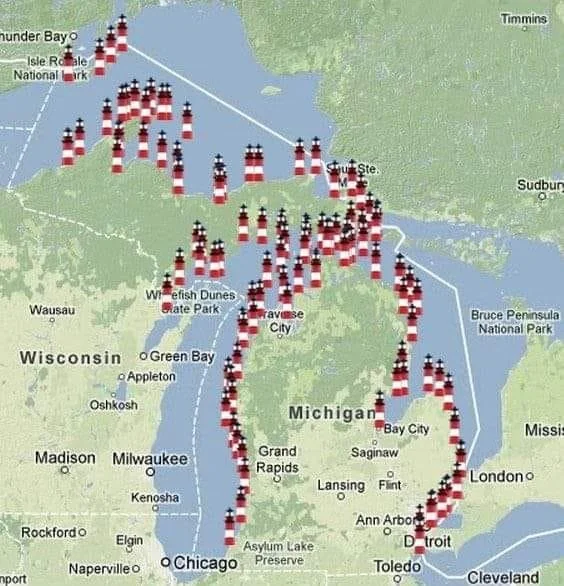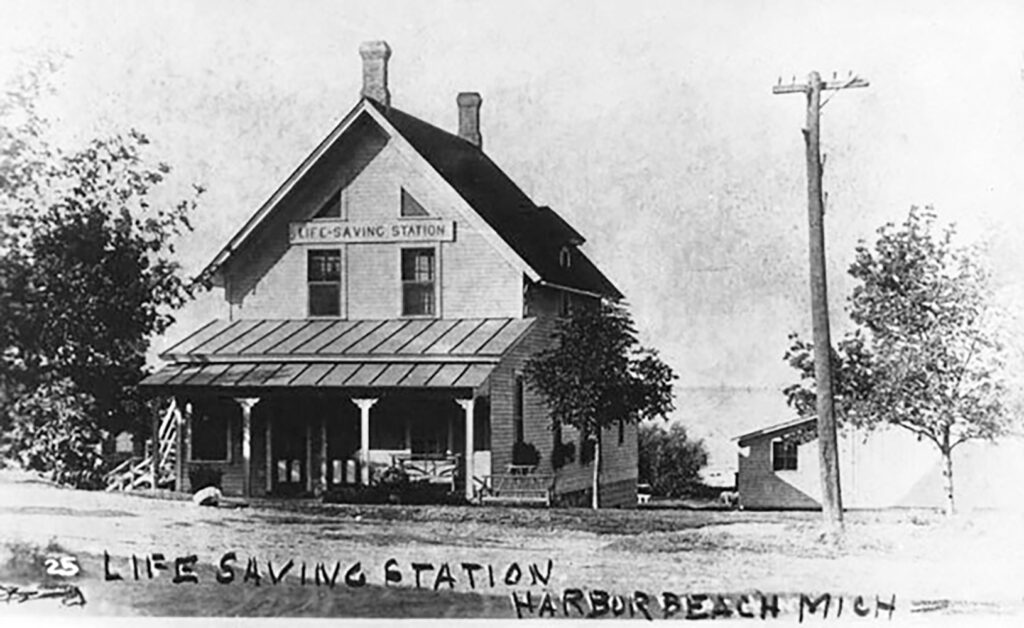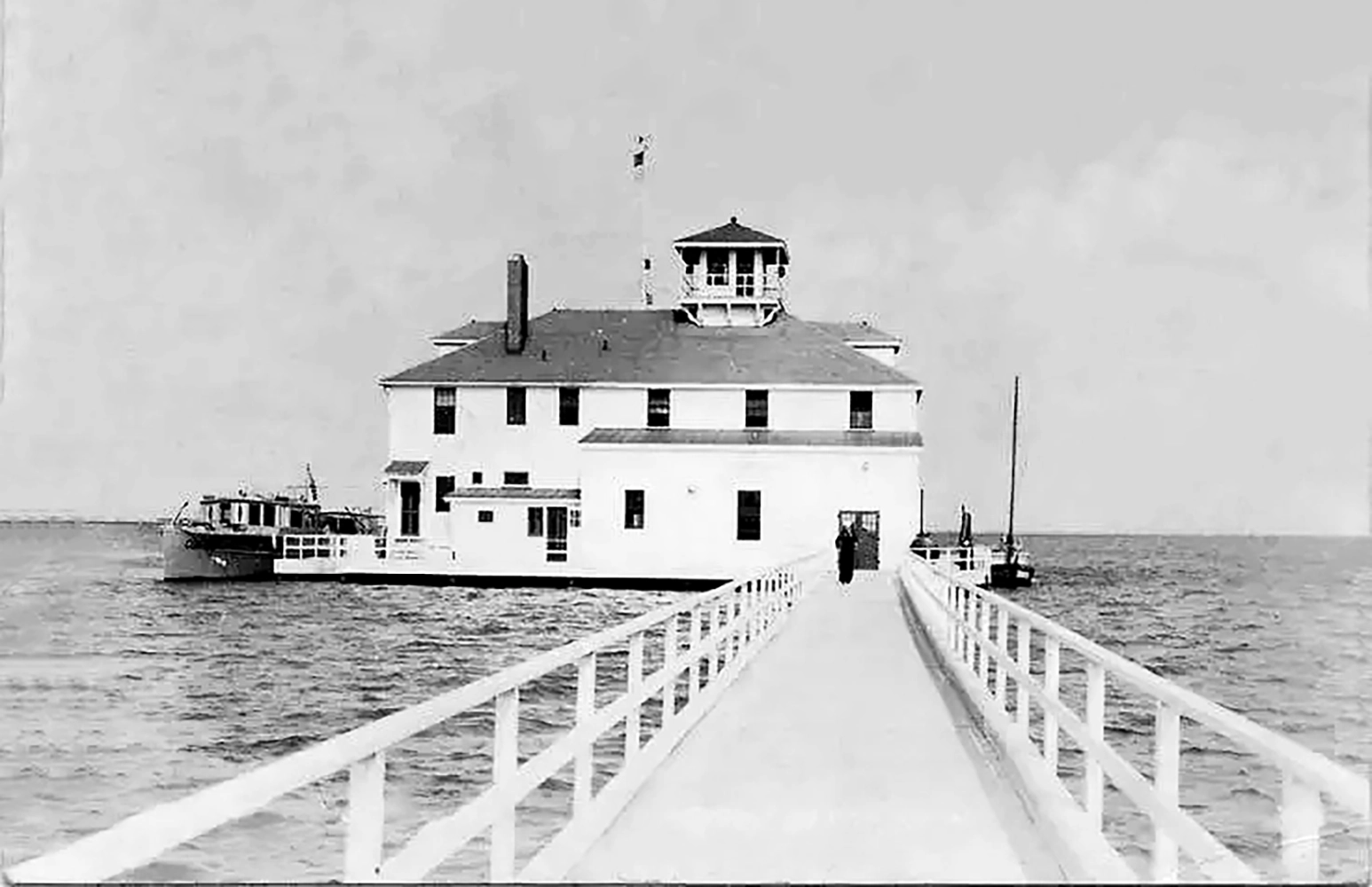“Immense bright lake! I trace in thee
An emblem of the mighty ocean,
And in thy restless waves I see
Nature’s eternal law of motion;
And fancy sees the Huron Chief…”
“Lake Huron” by Thomas McQueen
The peninsular state of Michigan (est. 1837) resembles an extended left human hand in a mitt with the thumb partly opened outward from the palm. And there, about where the quick of a thumbnail would be on the east side, is US Coast Guard Station Harbor Beach as it’s known today. It is estimated that since the 17th century, there are 6,000 maritime wrecks at the bottom of the mighty Great Lakes, one of which is Lake Huron. District 9, consisting of forty-eight active stations, is a United States Coast Guard area of operations based in Cleveland, Ohio. It is responsible for all Coast Guard functions on the five Great Lakes, the Saint Lawrence Seaway, and surrounding states, accumulating 6,700 miles of shoreline and 1,500 miles of international shoreline with Canada. It includes roughly 6,000 active duty, reserve, and civilian personnel serving duties such as search and rescue, maritime safety and security, environmental protection, maritime law enforcement, aids to navigation, and icebreaking. About sixty miles north of Port Huron, Station Harbor Beach (area pop. 1,604 in 2020) is one of eight USCG facilities in Sector Detroit. Originally named Barnettsville in 1855, the town was settled as a sawmill and shipping port, sending lumber down into and out of the Saginaw riverine system; eventually becoming known as Sand Beach by 1899, which changed again to Harbor Beach (est. 1910). It offers the largest man-made freshwater harbor of refuge to ships traveling between Port Huron and Pointe Aux Barques, against record temperatures between -22 and +95, with snowfall totaling as much as fifty inches, six months of the year.

Origins of a Harbor: From Sand Beach to Harbor Beach
Sand Beach was selected in 1872 as the site for an artificial harbor to provide for mariners caught in storms in the southern portion of Lake Huron. Construction commenced in 1873 on a project that provided for a breakwater of stone-filled cribwork to shelter an area of some 650 acres. When completed in 1885 at a cost of $975,000, the breakwater provided the only safe refuge on the western coast of Lake Huron between Tawas Bay and the St. Clair River, a distance of 115 miles. A pierhead light was placed in operation on 25 October 1875 at the angle of the breakwater to mark the structure until the project was complete and additional lights could be built. This first light consisted of a square, open-frame tower surmounted by an octagonal lantern room. A fourth-order lens produced a fixed white light at a focal plane of thirty-five feet. The main light commenced operation on 1 October 1885, and the fog signal followed suit a week later. The town of Sand Beach, justifiably proud of their harbor, changed its name to Harbor Beach, and the cast-iron lighthouse has subsequently been known as Harbor Beach Lighthouse. In 1934, a cable was run from shore to provide commercial power to the lighthouse and fog signal, and a radio beacon was established at the station. The last Coast Guard crew left the lighthouse after the 1967 shipping season, which actually ran until 2 January 1968, and no longer after that, the fog signal building was removed.

The tower’s Fresnel lens was removed in 1986 and placed on display at the Grice House Museum in Harbor Beach. In 2004, Harbor Beach Lighthouse, deemed excess by the Coast Guard, was offered at no cost to eligible entities under the provisions of the National Historic Lighthouse Preservation Act of 2000. Founded in 1898 as the US Coast Guard took over a Lifeboat Station for the US Lifesaving Service, Station Harbor Beach in the 1930s and saw heavy use during the Second World War, training new Coast Guard recruits. The station was closed as a full-time facility in 1973 due to budget restrictions, but it remained operational as a seasonal, summer-only station manned by USCG Auxiliary and Reserve Units. In 2004, Station Harbor Beach was formally re-opened as a full-time, fully crewed station and remains so today as part of the US Coast Guard’s 9th District, Sector Detroit.
Heroism and Hard Weather: Coast Guard Station Harbor Beach in Action
Station (SM) Harbor Beach is responsible for 1,035 square miles of Lake Huron, which encompasses 91 miles of rocky shoreline starting at Wild Fowl Point, in the northwest, and ending in Port Sanilac, to the south. The station was seasonalized [meaning not open in winter] in 2017 and is now a sub-unit of Station Port Huron. It resides within the harbor, leases slips from the city-owned marina, and is responsible for the area from Port Sanilac to Caseville.
The grit and determination of personnel at such remote stations is legendary, as recounted in the following incident which could as easily happen tomorrow there:
“In early October 1888, the St. Clair was one of six barges hauling a load of coal north on Lake Huron. A steamer named the Lowell was towing the barges off the eastern shore of the thumb when the convoy ran into an autumn storm. A strong wind out of the north-northeast and the resulting choppy waves made conditions extremely hazardous for the convoy, and eventually the towline either snapped or was intentionally severed.

The Lowell remained in the safety of the harbor, and two of the barges set sail for safer destinations like Port Huron, but the St. Clair, a decommissioned side-wheel steamer, found itself in distress. As the crisis unfolded, members of the US Lifesaving Station at Harbor Beach watched from the shore. A tugboat sitting in the safe waters of the harbor refused to come to the aid of the St. Clair, so Lifesaving Service Capt. George Plough ordered his eight surfmen to suit up and put their lifeboat in the water… With the waves crashing into the breakwall, the lifeboat headed back out toward the St. Clair, which had been brutalized by the storm. Its bow was almost underwater and its crew was huddled together at the stern, desperately awaiting their rescuers… As the lifeboat headed between the piers, a wave broached the vessel, spinning it violently and throwing its occupants into the lake.

Once in the water, they were pulled back and forth from the beach by a backwash created by waves crashing into the shore… The Lifesaving Service district superintendent would write, ‘Braver men never manned an oar.’ They were met with a hero’s welcome when they returned to Harbor Beach, and two of them would go on to become keepers of their own stations. ‘They were made of stern stuff,’ [marine artist] Robert McGreevy said at the time. The five St. Clair crew members were initially buried together in the Port Sanilac Cemetery in what was described as a pauper’s grave. Jones and one of his crew were eventually relocated to their hometown of Bay City. Graveratte, 30-year-old seaman George McFarland of Cleveland and 30-year-old Henry Anderson of Australia remain interred in the cemetery. A large gravestone was later placed at their burial site, adorned with an anchor and bearing an inscription recounting the events of Oct. 1-2, 1888.” In 1915, the life-saving service was combined with the United States Revenue Service and became the United States Coast Guard. A Coast Guard Station was built in 1935 at the foot of Pack Street. An earthen causeway was laid out into the lake for a four-bay garage.
Modern Day Operations
The station itself was built 300 yards offshore and connected to the causeway by a walkway. During World War II, the station was used for training and housed 100 Coast Guardsmen.
Coast Guard boats were stored in the rear of the station on a marine railway. When making a rescue, the guardsmen climbed aboard, and the boat slid down the rails into the water. In 1987, the old station was left vacant and fell into disrepair. It was torn down in 2004. The current Coast Guard Station, located north of the Harbor Beach Marina, was built in 1987. The new structure consists of offices, bedrooms, a recreation room, a kitchen, and a communications room. A large boat storage and maintenance building was built in 2008 to complement the station’s activities. The search and rescue boats are kept in the Harbor Beach Marina. Harbor Beach is proud to have hosted the life-saving service and the United States Coast Guard continuously since 1881.

Pictured here, the current USCG facility. This is a “sparkplug lighthouse” located at the end of the north breakwall entrance to this harbor of refuge on Lake Huron. Coast Guard TWS lists twelve members who served at this station under its current name, and three who served there when it was called Sand Beach Station; so named owing, as with other variably windward coastal areas of Michigan, to unusually plentiful pure sand deposits and meteorological lake-effect.
Read About Other Famous Military Units
If you enjoyed learning about American Coast Guard Station Harbor Beach by A3C Michael Bell, we invite you to read about other Famous Units on our blog. You will also find military book reviews, veterans’ service reflections and more on the TogetherWeServed.com blog. If you are a veteran, find your military buddies, view historic boot camp photos, build a printable military service plaque, and more on TogetherWeServed.com today.

0 Comments